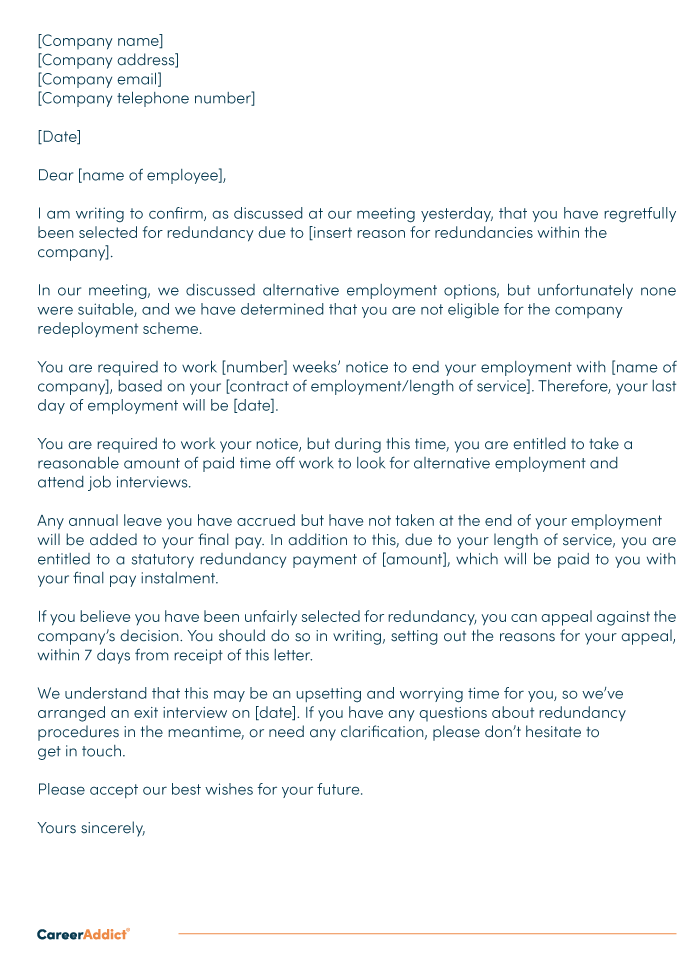If a Company Goes Bust Who Pays Redundancy? Lawful Insights for UK Personnel
If a Company Goes Bust Who Pays Redundancy? Lawful Insights for UK Personnel
Blog Article
Investigating the Interplay In Between Firm Redundancy and Organizational Flexibility for Future Development
In the dynamic landscape of today's company globe, the intricate partnership between company redundancy and organizational flexibility emerges as a crucial element for sustained development and success. Business often face the obstacle of striking a fragile balance in between maintaining a level of redundancy to minimize threats and cultivating flexibility to respond promptly to the ever-evolving market needs.
Significance of Firm Redundancy
Business redundancy is an essential element that improves business strength and mitigates functional dangers. By integrating redundancy steps within the organizational framework, business can much better stand up to unanticipated interruptions and variations in business environment. Redundancy works as a strategic buffer, enabling firms to adapt and respond efficiently to unexpected obstacles without endangering crucial procedures.
One secret aspect of the significance of company redundancy is its function in making sure connection throughout times of dilemma. When faced with abrupt changes or emergencies, repetitive systems, resources, or personnel can step in to keep essential functions and avoid widespread disturbances. This connection not only safeguards the company's track record and client count on but additionally reduces financial losses and operational downtime.

Methods for Business Versatility

Producing adaptable organizational structures that permit for quick modifications to market characteristics and client demands is necessary for remaining competitive in a quickly evolving setting. By proactively determining potential disturbances and chances, organizations can proactively flourish and adjust in an ever-changing company landscape.
Balancing Redundancy and Flexibility
Attaining an unified balance between functional redundancy and business flexibility is extremely important in navigating the complexities of a dynamic service atmosphere. Redundancy within a business offers a safeguard, making certain connection and stability in procedures. However, an excess of redundancy can result in inefficiencies and impede flexibility to changing market conditions. On the other hand, business flexibility enables companies to respond immediately to outside interruptions and confiscate new chances. Striking the ideal equilibrium in between redundancy and versatility is a delicate procedure that calls for a deep understanding of the company's objectives, sector characteristics, and threat resistance.
To accomplish this balance, companies need to conduct routine assessments of their operations to determine locations where redundancy is essential for risk mitigation and where flexibility can drive development and development. Applying flexible frameworks, cultivating a culture of continuous understanding and renovation, and urging open interaction across all degrees of the company are key strategies to balance redundancy and versatility successfully. By straightening these two vital aspects, firms can position themselves for sustainable development and success in an ever-changing service landscape.
Study on Adaptation Success
In taking a look at instances of successful business adaptation, it becomes evident that the interaction in between functional redundancy and flexibility is a specifying consider forming resistant companies. One compelling case research study is Website that of Netflix. Originally a DVD rental solution, Netflix showed impressive adaptability by transitioning into a streaming platform when digitalization disrupted the market. By purposefully buying technology and material development, Netflix not just grew however endured in a rapidly progressing market. An additional standout example is Amazon. Starting as an online book shop, Amazon constantly adjusted its service version, broadening into diverse markets such as cloud computing and expert system. This adaptability enabled Amazon to remain in advance of rivals and meet transforming customer demands. Lastly, Adobe offers a significant illustration of effective adaptation. The firm changed from selling software application licenses to a subscription-based version, making certain recurring earnings streams and boosted consumer involvement. These instance research studies underscore the relevance of operational redundancy combined with business versatility in fostering long-lasting development and competition.
Building Strength for Future Development
Building strength for future growth calls for a calculated alignment of operational processes with market characteristics and arising patterns. Firms must adapt to altering settings by promoting a society of versatility, innovation, and continual renovation. Resilience entails not just recuperating from obstacles but also proactively preparing for future difficulties. One crucial facet of building durability is spending in durable danger management methods to minimize potential disturbances. This includes scenario preparation, branching out supply chains, and creating backup prepare for different backups (who pays redundancy money).
In addition, cultivating strong partnerships with stakeholders, such as clients, employees, vendors, and the community, is vital for preserving and weathering uncertainties count on and assistance during stormy times. Effective communication and transparency play an essential function in structure strength, as they help line up assumptions and assist in partnership in browsing uncertainties.
Additionally, companies need to focus on understanding and advancement initiatives to upskill staff members and equip them imp source with the necessary devices to adapt to changing scenarios. By purchasing their labor force, firms can boost their versatility and dexterity, inevitably reinforcing their strength for lasting future development.
Verdict

In the dynamic landscape of today's business world, the detailed connection in between firm redundancy and organizational adaptability arises as an important variable for sustained development and success. Companies usually encounter the challenge of striking a delicate balance between maintaining a level of redundancy to minimize dangers and cultivating versatility to react swiftly to the ever-evolving market demands.To achieve this balance, business require to conduct routine analyses of their operations to recognize areas where redundancy is needed for risk mitigation and where versatility click this link can drive technology and development.In final thought, the interplay in between company redundancy and organizational flexibility is vital for future growth. Building strength via a mix of redundancy and flexibility will certainly ensure that business are prepared for the difficulties of the future.
Report this page